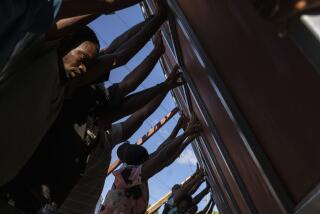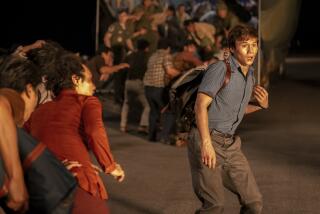Better Times Are Here for Laos, but It’s All Relative
- Share via
VIENTIANE, Laos — The sprawling, open-air market is doing fine business these days. Japanese television sets and Soviet-made stoves are on sale. So are detergents, soy sauce and cloth smuggled across the Mekong River from Thailand. People say local rice and vegetables have rarely been in such plentiful supply.
The central market of Vientiane, the capital, is one sign of better times in this poor Indochinese nation, which this year marks a decade of Communist rule. In the early years of the regime, many predicted Laos was on a hopeless downward spiral.
The U.N. Food and Agriculture Organization says Laos today can nearly meet the annual, 1.2-million-ton domestic demand for rice, thanks in part to the introduction of free-market style incentives and a slowdown of collectivization.
Among Poorest Nations Laos is still classified as one of the world’s poorest nations, with an annual per capita income hovering around the equivalent of $100.
But its population is low, resources are adequate and the lifestyle is simple; self-sufficiency for most is a bowl of rice, some fish and a sarong.
The apparently successful movement toward economic self-reliance has not been matched in the political arena. The Americans who held sway in Laos for years before the Communist victory in 1975 have been replaced by Vietnamese advisers and more than 40,000 of Hanoi’s troops along with an estimated 5,000 Soviet technicians and advisers.
Between Two Forces “Laos is a poor, landlocked country,” said a Western diplomat here. “It has almost no choice: it must either be dependent on pro-American Thailand or pro-Soviet Vietnam.”
Vice Foreign Minister Soubanh Sritthirath said in an interview the idea for a Hanoi-dominated Indochinese federation has been “thrown into the waste basket.” Instead, he said, the three Indochinese nations--Vietnam, Cambodia and Laos--are pursuing “all-round cooperation” that extends to mutual defense.
Thailand and Laos share a very similar culture and language. Much of Laos’ trade still comes through Thailand. But suspicions are rife among the Communist leaders.
Economic dependence on Thailand and the West will be further reduced with the improvement of Highway 9 linking the Laotian town of Savannakhet with the Vietnamese seaport of Da Nang; the completion of an oil pipeline to Vietnam and, in the future, the reconstruction of a railway line.
Some Indochina experts in Thailand and elsewhere claim the Vietnamese leadership in Hanoi is making all key decisions in Laos, something denied by Vientiane officials, who characterize Soviet and Vietnamese aid as having stabilized a country that suffered great wartime devastation and a semi-feudal regime before opting for socialism.
Ten years later, the government of 64-year-old Kaysone Phomvihane appears firmly entrenched. An insurgency of the tough Hmong hill tribes has subsided--after what the United States claims was a brutal campaign that included the use of Soviet-supplied toxic gas. Laotion officials charge that the Chinese are attempting to organize rebel tribesmen on the remote northern border, while in the southern panhandle anti-Communist guerrillas mount small-scale raids.
A reported improvement in the human rights situation may be a reflection of greater political stability. The Laotian government recently told a visiting American professor, MacAlister Brown, that re-education camps for what the West considers political prisoners had been dismantled.
When the victorious Pathet Lao marched out of the jungles and mountains in 1975, as many as 60,000 people were dispatched to labor camps and re-education centers. The Communists, having toppled the U.S.-propped Vientiane government, were then flying the orthodox Marxist banner.
More than 10% of the population of about 3 million--almost the entire former elite--fled the country. Peasants showed their resentment at collectivization attempts by reducing production. The economy began to fall apart.
Kaysone, who is both premier and Communist Party chief, switched directions in late 1979. Farmers and private traders were given more leeway; greater effort was channeled into agriculture, and the timetable for socialism was set back.
In 1981, Laos had a record food harvest of more than 1 million tons and U.N. FAO sources believe its target of 1.4 million tons by 1990 is “very possible.”
Vice Foreign Minister Soubanh said agriculture will continue to get priority along with exploitation of Laos’ great forest wealth. Mining and light manufacturing are also to be expanded.
Life Is Difficult Life in Vientiane is difficult, especially for government employees. A middle-level civil servant earns about 500 kip a month ($14 at the official exchange rate), which is the price of a kilogram (2.2 pounds) of pork on the free market. Government officials, however, receive food rations and other benefits.
Market vendors, restaurateurs, shopkeepers and others on the private economy can easily earn three times this amount. Many in Vientiane are also helped by money from relatives who fled the country.
The black market rate for the U.S. dollar is 250 kip, while hard currency from abroad also can be exchanged at an official “favorable rate” of 108 kip and used to purchase imported items.
‘Just Able to Live’ “We’re just able to live. Forget about being rich,” says the owner of a Western-style restaurant. There are six such establishments left in Vientiane, but long gone are the bars, night clubs and rock music of the “American era.”
Vientiane today is a very sober and sleepy place, its 1975 population of 200,000 reduced by almost a half. Chickens and goats wander in the streets and vegetable plots ring private houses. Traffic lights are largely for the benefit of bicyclists.
Most buildings are shabby and one of the few roads not marred by potholes is Phonekheng, along which are found embassies, the residence of Kaysone and Vientiane’s “Arch of Triumph,” a monument to war dead that was begun in the late 1950s and still incomplete today.
Vientiane residents watch Thai television and avidly follow gossip about Thai movie stars. Far less popular is government television, which features Soviet and Vietnamese material for just six hours a week.
Buddhism still appears to be a key feature of life for the average Laotian.
Thong Khoune Anantasounthone, the government-appointed leader of the religion, said in an interview that there are 16,300 monks in the country. He lauded the government’s role in religious affairs and noted that monks in today’s Laos have to become involved in the “real scientific life of socialism.”
More to Read
Sign up for Essential California
The most important California stories and recommendations in your inbox every morning.
You may occasionally receive promotional content from the Los Angeles Times.













